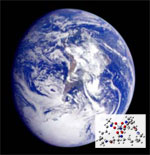The Competition for Iron Impacts the
Global Carbon Cycle
Phytoplankton are microorganisms that live in the ocean surface waters and are important because they act as lungs for the planet, consuming carbon dioxide and producing oxygen. Phytoplankton account for an astounding 50% of the total biological uptake (or sequestration) of carbon dioxide annually. Understanding the factors that affect the growth of phytoplankton, is therefore of particular importance for this carbon sequestration, since the amount of released carbon dioxide continues to increase world-wide. Phytoplankton need iron as a key nutrient, and being able to accumulate a sufficient amount is a much greater challenge than previously believed, according to a recent study by a team of researchers working in part at SSRL Beam Lines 11-2 and 2-3. The findings revealed that siderophores—special chelating molecules released by marine microorganisms to convert and gather iron in seawater, thereby making it available for plankton to absorb—have a harder time keeping the iron bound than was previously assumed. The results were published in the July 15, 2008 edition of Geochimica et Cosmochimica Acta.
Iron is a crucial element for living organisms, playing an important role, for example, in oxygen transport and the formation of enzymes. But because it is so reactive with oxygen, despite its being plentiful in the environment, most iron is locked up in compounds. Living organisms, however, have developed strategies for stripping, or chelating, iron out of other compounds. Siderophores—the chelating compounds released by marine microorganisms—strip bound iron atoms and store them in a form that can be absorbed by plankton. Until now, scientists considered iron sequestered within siderophores to be highly stable and relatively safe from outside scavengers.
Using a technique called Extended X-ray Absorption Fine Structure (EXAFS), the
team discovered that iron captured by siderophores is in fact susceptible to
recapture by manganese (Mn) oxides, another plentiful component present as
minerals in seawater. Although the specific role of Mn oxides in seawater
remains unclear, it is now apparent that its presence could have a disruptive
impact on the growth of plankton. A better understanding of the factors
associated with plankton growth may one day lead to important environmental
remediation strategies, including reducing atmospheric carbon dioxide.
To learn more about this research see the full Scientific Highlight
Duckworth, O.W., Bargar, J.R. and Sposito, G., 2008. Sorption of ferric iron from ferrioxamine B to synthetic and biogenic layer type manganese oxides. Geochim. Cosmochim. Acta, 72: 3371-3380.


